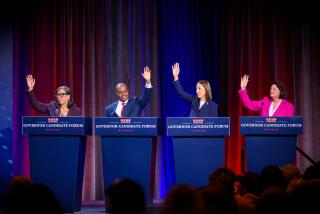Here we go again: Candidates pledge to search for ‘waste, fraud and abuse’
Meg Whitman will “root out fraud” and “cut wasteful spending.” Carly Fiorina wants to eliminate “the billions of dollars of waste and bloat that sits in our federal budget.”
Ho-hum. Is it campaign time again? As the crocus heralds the coming of spring, the sure sign that we’re working up to a major election is that we start hearing all about cutting the “waste, fraud and abuse” in government spending.
Waste, fraud and abuse, or as I prefer to think of it, WFA, is the WMD of domestic politics. The search for WFA is handy for rallying the campaign troops, but the results on the battlefield tend to disappoint.
“Railing against waste in government is practically as old as government,” says Tim Hodson, executive director of the Center for California Studies at Cal State Sacramento. “It’s a comforting slogan that doesn’t stand up to any sort of rigorous analysis. That’s not saying you can’t be more efficient, but it’s not enough to fix the budget.”
As a political trope, WFA is nonpartisan, and useful to campaigns at the state and federal level alike. This year it’s cited by Whitman and Fiorina, who are running for the GOP nominations for governor and U.S. senator, respectively. Even President Obamais falling back onthe theme. He told a recent Midwestern rally that healthcare reform would help stamp out up to $100 billion in wasteful, fraudulent and abusive bills to taxpayers.
What makes WFA so expedient is that it allows the speaker to ignore or evade really tough questions on policy, such as: Which programs and services will you cut to close the deficit? Consider its use by Whitman, today’s most assiduous WFA hunter.
Whitman promises to use the skills she developed as chief executive of EBay to find $15 billion in savings in the state budget, mostly by wiping out WFA in existing programs and running others with the rigor of a business. One of her big ideas is to cut 40,000 workers from the state payroll. This is a crowd pleaser, because nobody loves a fat old bureaucrat sleeping behind a desk, which is what all these people are, right?
Yet it’s not really fair to treat people as WFA just because they work for the state of California. One fact Whitman doesn’t mention is that California’s government workforce is already among America’s leanest -- the ratio of state employees to population is the third lowest in the country, according to 2008 figures from the U.S. Census. Add in local employees and we’re still the eighth lowest.
The Palo Alto-based Center for the Continuing Study of the California Economy calculates that more than 37% of California public employees work in K-12 education and that this state’s ratio of K-12 employees per resident is the fifth-lowest in the country, at 182 per 10,000 residents. Texas, which is held up to us as lean where California is bloated, has the fifth-highest K-12 ratio, with 275 per 10,000 residents. (Though it’s possible that half of those Texas workers are employed undoing the pedagogical damage inflicted by that state’s Stone Age textbook policies.)
Although almost all of California’s schoolteachers are technically employed by local school districts, two-thirds of district funds come out of the state budget. Meanwhile, California State University and the University of California account for more than 200,000 workers on the state payroll.
What this means is that Whitman can hack away only at a relatively small portion of the payroll without affecting her pledge to “fix education.” (That said, her proposal to give local administrators more discretion in spending the funds they get from the state is an excellent approach.)
The search for WFA has a long history. Ronald Reagan pledged to ferret out enough WFA to cut the federal budget by more than 6% (sometimes he said 10%). One of his first steps, however, was to fire 15 departmental inspectors general, whose jobs involved finding WFA.
Reagan had a touchingly artless view of the prevalence of WFA, derived from his taste for colorful anecdotes. His favorite involved a Chicago welfare queen who had supposedly defrauded the government of $150,000. In real life, the woman had been convicted of receiving $8,000, but never mind that. Reagan trotted out the story so often that his aides would nudge one another when they detected his windup, as if to say, “Here he goes again.”
Reagan impaneled the so-called Grace Commission, whose chairman, industrialist J. Peter Grace, promised to unearth billions of dollars of the elusive WFA. The commission’s eventual proposals included taxing Social Security benefits, adding soy meat-extender to school lunches ($84-million savings over three years), and eliminating the regulatory agencies that oversaw industries represented by the panel’s members.
Then there was Gov. Arnold Schwarzenegger’s promise to “blow up the boxes” of state government. To this end, he created the California Performance Review, a sort of junior Grace Commission instructed to reorganize the government along hyper-efficient lines.
The panel mounted the predictable attack on regulatory boards that annoyed influential business leaders. Many boards it proposed killing were well-regarded bodies that conducted their work in public; their jobs would be taken over by bureaucrats making decisions in their office suites, possibly after soliciting input from the governor’s campaign contributors.
Hodson observes that WFA campaigns often are not fiscal, but ideological. “It’s about what you define as waste,” he says. Berkeley grads think that building UC Merced was a waste of money, Cal State faculty think UC professors are overpaid, businessmen with Cadillac healthcare plans think Medi-Cal is a waste, advocates for the homeless point to the tax breaks enjoyed by the wealthy.
Lord knows there’s waste and fraud in government -- overpayments to crooked Medicare providers, civil servants who don’t pull their weight, programs that live on long after their original rationale is dead and buried. But ferreting it out can’t be done ideologically, casually or on the cheap: The supposedly money-saving furloughs of workers at the Franchise Tax Board are projected to cost the state $363 million in tax collections this year, because they include employees assigned to enforcing the tax rules.
History shows us that the WFA yield is always far smaller than is predicted or pledged at campaign time. That’s because WFA projections are almost always pulled out of a hat. They’re designed to sound impressive -- billions always sound bigger than millions (as they should). WFA is almost always a weapon used by challengers against incumbents, because it’s always easier to issue blanket condemnations when you don’t have the knowledge that comes from experience.
Once these challengers get into office, they discover the hard truth that the search for waste, fraud and abuse often leads to a big empty hole in the sand. By then, of course, it’s too late to remind them that when they devoted their campaign rhetoric to the subject, it was our time they were wasting.
Michael Hiltzik’s column appears Sundays and Wednesdays. Reach him at [email protected], read past columns at www.latimes.com/hiltzik, and follow @latimeshiltzik on Twitter.
More to Read
Get the L.A. Times Politics newsletter
Deeply reported insights into legislation, politics and policy from Sacramento, Washington and beyond. In your inbox three times per week.
You may occasionally receive promotional content from the Los Angeles Times.











